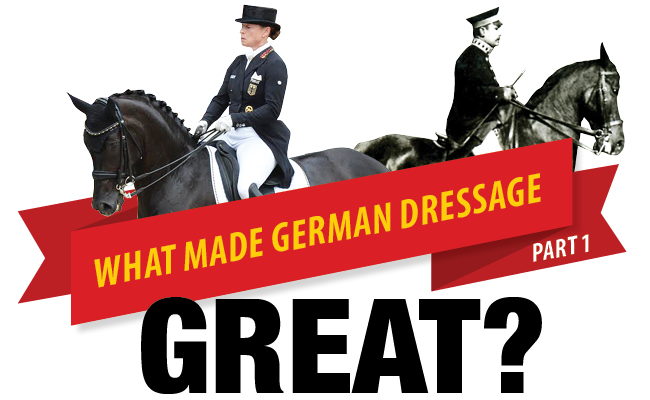
Christopher Hector takes an in-depth look at German Dressage…
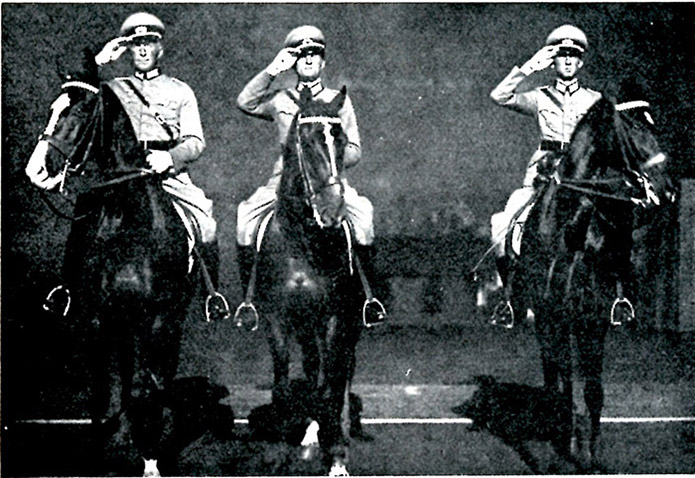
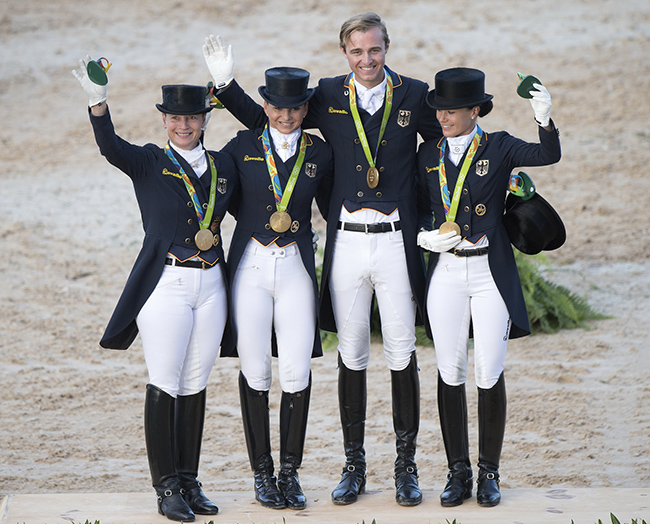
What is it? Breeding? Training? The Culture? Great Trainers? Education? Wonderful Administrators? Fantastic fans? Luck? Or perhaps we will find that Germany’s pre-eminent position in the world of dressage, is the result of a little of all of the above…
Growing up over the last few decades, you might get the impression that Germany has always dominated Olympic dressage competition, but this is not true. The first two Games, Stockholm and Antwerp were dominated by Sweden. The first German team gold came in 1928 at Amsterdam, led by individual gold medallist, Carl-Friedrich Freiherr von Langen riding Draufgänger.
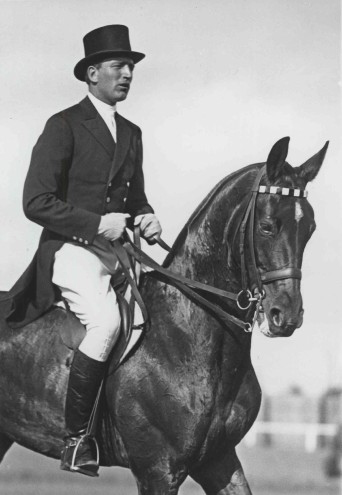
The first gold medallist, Carl-Friedrich Freiherr
No medals at Los Angeles in 1932 since Germany, like the rest of the world, chose not to attend, but 1936 was a total triumph, team gold, and individual gold, Kronos and Heinz Pollay, individual silver, Friedrich Gerhard and Absinth.
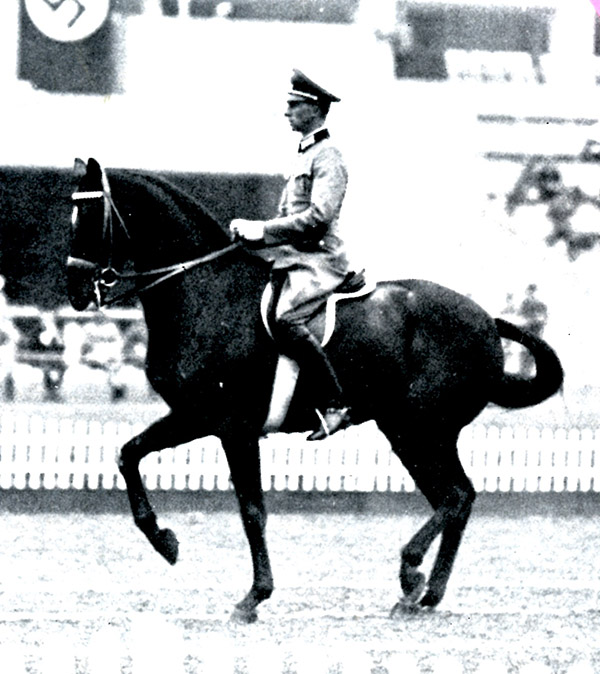
Gold for Kronos and Heinz Pollay
In 1952, the Federal Republic of Germany took home the team bronze, but there were no individual medals. At Stockholm in 1956, Liselott Linsenhof won individual bronze on Adular, while a United Team of Germany took team silver. There was no team competition at Rome because participation was limited to two riders from each nation, although Josef Neckermann took individual bronze with Asbach.
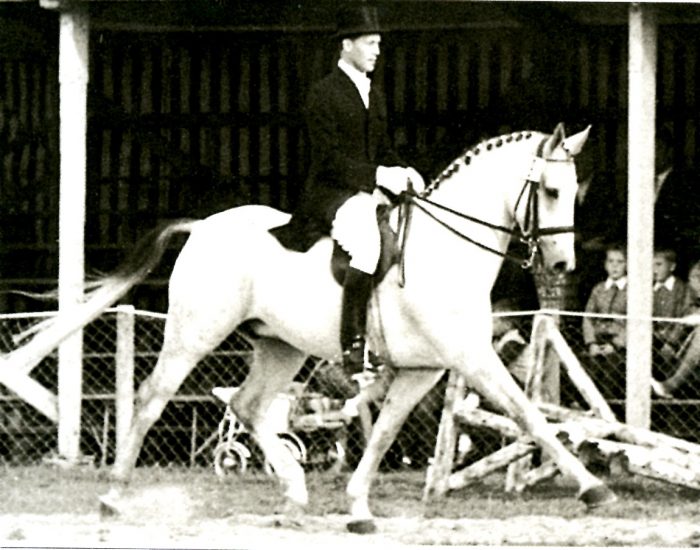
Harry Boldt and Remus – individual silver, team gold at Tokyo
The team at the 1964 Tokyo Games – Boldt, Klimke, Neckermann – took gold and opened up the modern era of German domination. The Germans have won 11 team gold medals out of 14 on offer from Tokyo to Rio.
Why? What makes them so good?
TRADITION
Tradition plays a crucial rôle. Many of the very early developments in dressage occurred in Austria at a time when the nation of Germany did not exist, but was part of the Holy Roman Empire, and equestrian talent started at the top: in 1667, Kaiser Leopold of the Holy Roman Empire, was a star in the elaborate horse ballet – or carrousel – staged in Vienna.
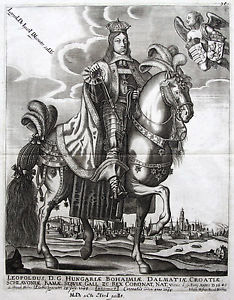
“There were forty-nine riders with the Kaiser, of whom nine rode courbetting horses, four rode horses which two tracked in canter, and four horses which executed High School jumps (such as the Capriole, etc)… The Kaiser made his entrance in the first figure with several elegantly executed Courbettes…” (Horseman’s Progress by Vladimir S Littauer)
We find the first reference to the Spanish Riding School in Vienna in 1572, and the beautiful Imperial Manège was built in 1735.
It is interesting that while the Spanish School has produced a number of gifted instructors who have shaped the development of modern competitive dressage in Germany, the School itself became a museum exhibit and the last rider to take on international competition was Podhajsky who competed at the 1936 Games.
next the role of the Cavalry Schools
CAVALRY SCHOOLS
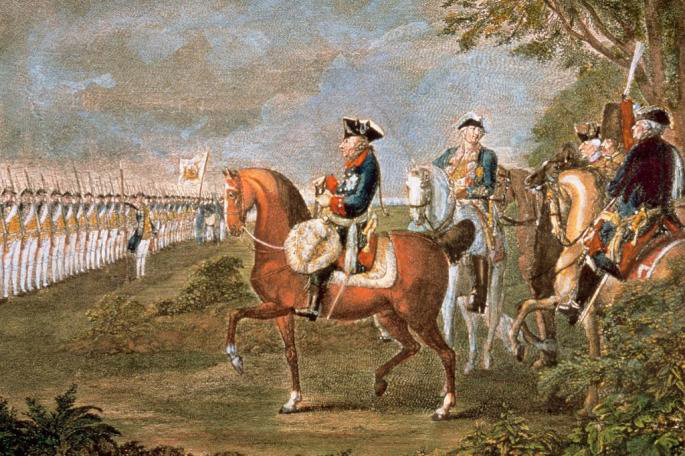
Frederick the Great inspects the troops
When Frederick the Great ascended the Prussian throne in 1740, he changed the Cavalry emphasis from High School parade to cross country gallops, and proved the value of the change in the Seven Years War (1756-1763). Is this perhaps the key change? That German Cavalry Schools started teaching a simpler more horse friendly, rider friendly way of riding, that could spread throughout the community, while other Cavalry Schools – like the French – remained mired in the complicated manoeuvres of the old High School. Certainly in France the majority of riders turned away from dressage, discovered Caprilli and they became a nation of jumping riders, while their Cavalry School, the Cadre Noir, lingers on as a quaint Baroque tourist attraction and their dressage disappeared in a maze of theory and counter theory.
Back in 1909, British cavalry officer, Major W. H. Greerly, Brigade Major of the 1st Cavalry Brigade of the 12th Lancers, delivered a paper on the German cavalry: The Cavalry Of Frederick The Great: Its Training, Leading And Employment In War.
While Greerly focused mainly on technical arrangements on the battle field, there is no doubt that the speed with which the Prussian Cavalry could move was of prime importance, although the cavalry that Frederick inherited when he came to power was far from what it became: “My father left me a bad cavalry: hardly an officer who knew his duty. The men were afraid of their horses and hardly ever mounted them; they only knew how to drill on ‘foot’.”
“The cavalry are so bad that it isn’t worth the devil’s while to take them away. They can drill with the precision of Grenadiers, but are equally slow; in front of the enemy they are useless, and invariably arrive too late.”
Because of the discipline of the army, change came quickly and the cavalry became a potent weapon. In the ten years of peace, from 1745 to 1756, Frederick issued directives that had lasting effect:
“The cavalry must be instructed man by man, and horse by horse. The officer must see that the men ride continually, so that each man can turn and twist his horse and be completely its master.” He also said that: “the day was wasted on which the rider had not exercised his horse.”
According to Major Greerly: “The point that stands out most clearly, is that Frederick never mistook the means for the end; he aimed at producing a good ‘campaign horse’- one that would go collected and in the rider’s hand over the roughest ground, and could be trusted to jump with safety all ordinary obstacles to be met with in the field. In the same way every rider was to have his horse completely under control, and to have such complete confidence in his mount that he could devote his whole attention to keeping his direction and his proper position in the ranks.” This is a long way from practicing Airs Above the Ground or the School Walk, and I would suggest, laid the basis for the diffusion eventually through Germany of a way of riding and training that was relatively simple and effective. It also promoted the breeding of horses in Germany.
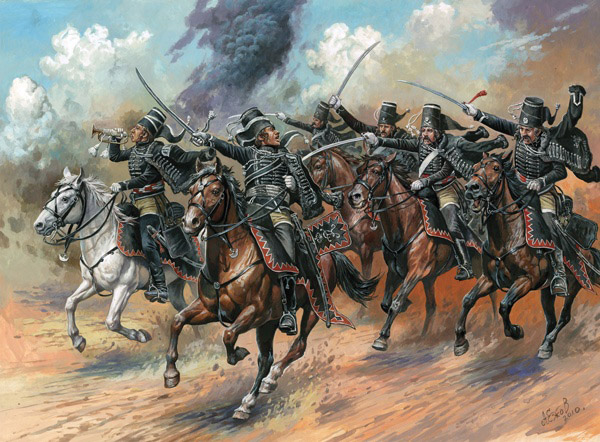
The German Cavalry charge became a fearsome weapon…
the influence of breeding is next
HORSE BREEDING
According to Sylvia Loch in her splendid, Dressage – The Art of Classical Riding, “By now (the end of the eighteenth century), the German cavalry horse was tall, streamlined, relatively big-boned and clean-limbed. Cold-blood horses were relegated to logistic or agricultural duties, and the short-coupled, smaller Baroque horses, which had earlier contributed so much to breeding, gave way to the more horizontal frame of the modern cross-country horse. The East Prussian (today’s Trakehner) was the most popular riding or cavalry horse displaying not only speed and versatility, but also courage and hardiness in drawn-out campaigns. For Hanover, the studs of Westphalia, Mecklenburg and Pomerania were producing strong artillery horses which also displayed much stamina.”
What was to become the cradle of the modern dressage horse, the Hanoverian Stud at Celle, was initially founded in 1735 by the Elector of Hanover, who was also George II, King of England. He decreed that ‘we shall set up a public stud, as a special favour, with twelve stallions to start with.’ Roger Brown – presumably an Englishman – was the first huntsman of staghounds at Celle, and he was sent to Holstein to purchase the 12 founding stallions.
By 1745 there were 50 stallions at the stud, mainly still from Holstein. From about 1775 onwards, home-bred stallions from Mecklenburg and England began to dominate the scene. By 1776, the Celle stud had grown to a point where it was transferred from the King’s personal responsibility, to that of the government.
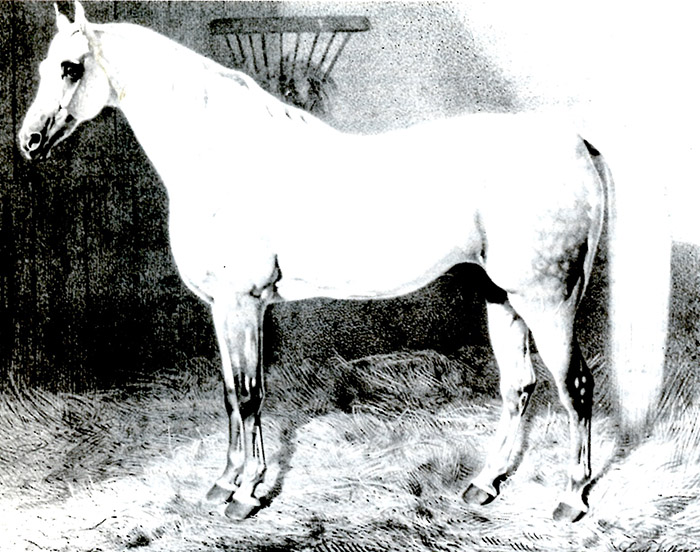
Sebras – an English part-Thoroughbred – stood from 1846 to 1863
More and more Thoroughbred stallions were imported – now directly from England rather than via Mecklenburg, until by 1840, one third of the stallions were Thoroughbred and the remaining two-thirds were either half-bred or quarter bred. And the breeding system was becoming sophisticated – from 1844 onwards, all stallions standing in Hanover had to be licensed, the number of private studs fell, and the influence of the State Stallions grew – a legacy that would greatly shape the future of the breed.
Yet another bloodline was added to the mix. The brothers, August and Friedrich von Spörken had good connections in England, and while visiting the UK, Friedrich became aware of the English Coach horses “which were mostly large-framed, with substance and possess great courage and endurance. They were capable of galloping for long periods without showing any great signs of tiredness. They had mostly been developed by using Thoroughbred blood on native foundation mares, especially those originating from the counties of Yorkshire and Norfolk, and from the Holderness area of East Yorkshire.”
(The Hanoverian by Christian Freiherr von Stenglin).
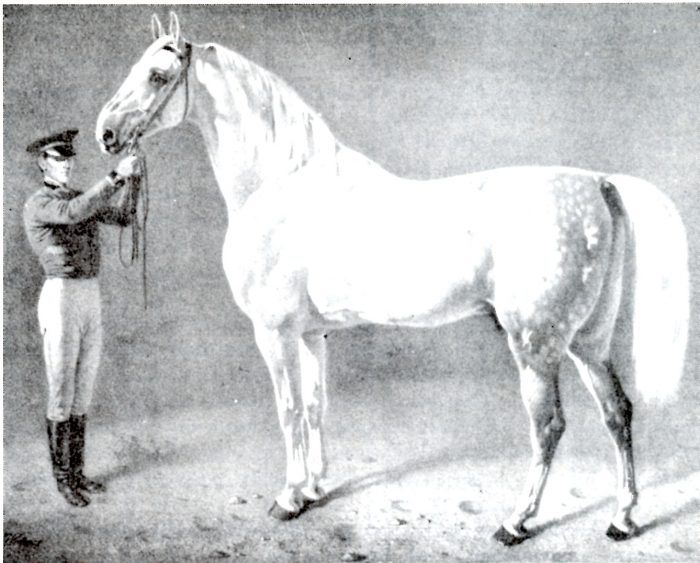
Holderness was one of the Yorkshire Coach Horse stallions, standing from 1844 to 1861
Between 1830 and 1890, about 100 of the English Coach Horse stallions were installed at the state stud, and they were very popular with the breeders.
In the period after 1850, the state stud had to balance the demands of the farmers, who wanted big heavy horses to work the fields, and the army, who wanted tough, courageous horses for the cavalry.
In 1867, the Society for the Promotion of Hanoverian Horse Breeding formulated the first breeding policy. The aim was: To produce a large, powerful horse with substance, a strong coach horse and at the same time a useful army horse.
At the beginning the twentieth century, the breed authorities became worried that the horses were becoming too big and losing some of their courage and action. New blood was required and it came in the form of the English Thoroughbreds – Kingdom (at Celle 1882 – 1898), Devils Own (1894 – 1906) and Adeptus (1884 – 1904).
More follows
Many Hanoverian stallions are available in Australia from International Horse Breeders – www.ihb.com.au
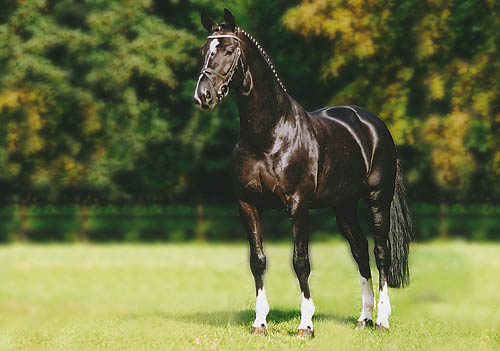
Including the great D line representative, De Niro
The D line of Devils Own and the A line of Adeptus still survive, as explained by Ludwig Christmann in his paper, The bloodlines of the Hanoverian, which he kindly revised and brought up to date specially for this article:
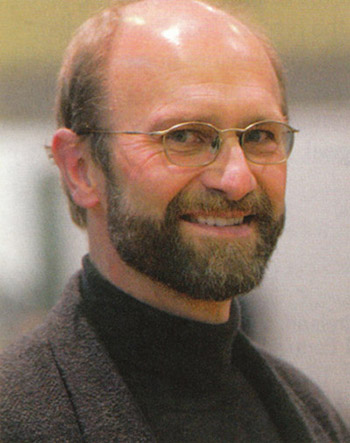
A/E-line
Adeptus – founder of the line
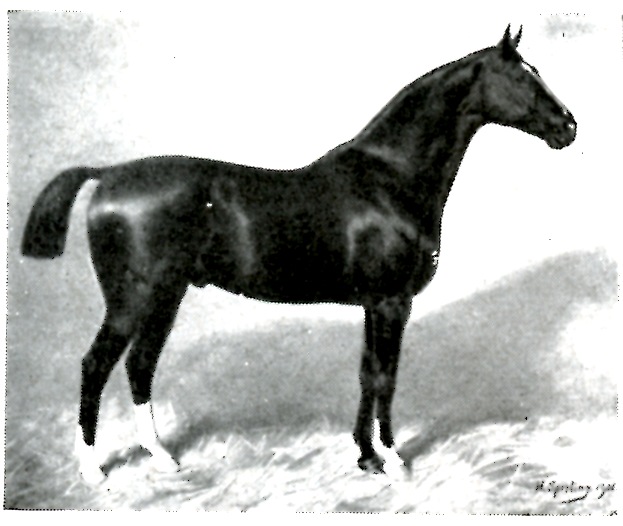
And his son, Alnok
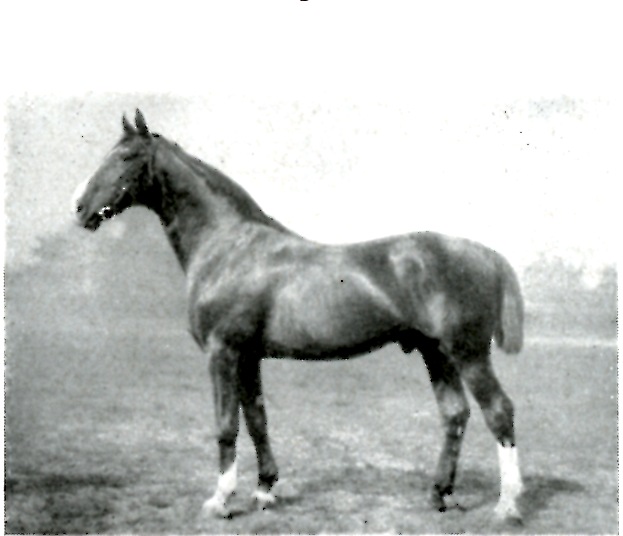
And Alnok’s son, Alderman
A-line was founded by Adeptus XX, the stallion was used for breeding from 1884-1904. Most important was his grandson Alderman, and through the Alderman son, Alkoven, this line produced the famous stallion Agram (1942-62), an outstanding producer of jumping horses. In Agram’s color and type, one sees the influence of Arabian blood through his Amateur I mother.
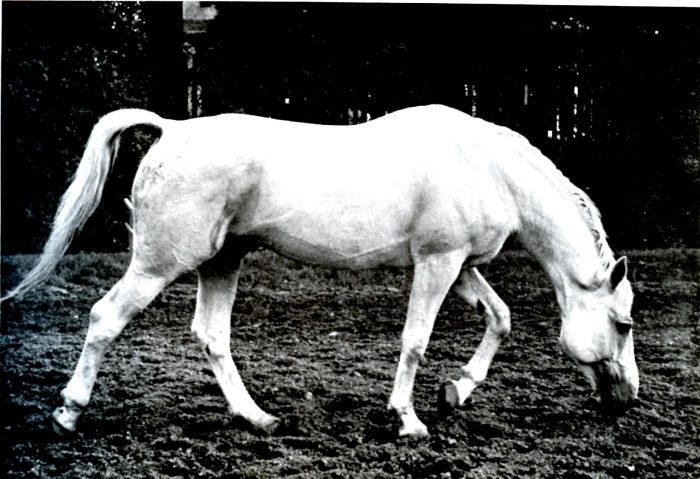
Agram – jumping stallion
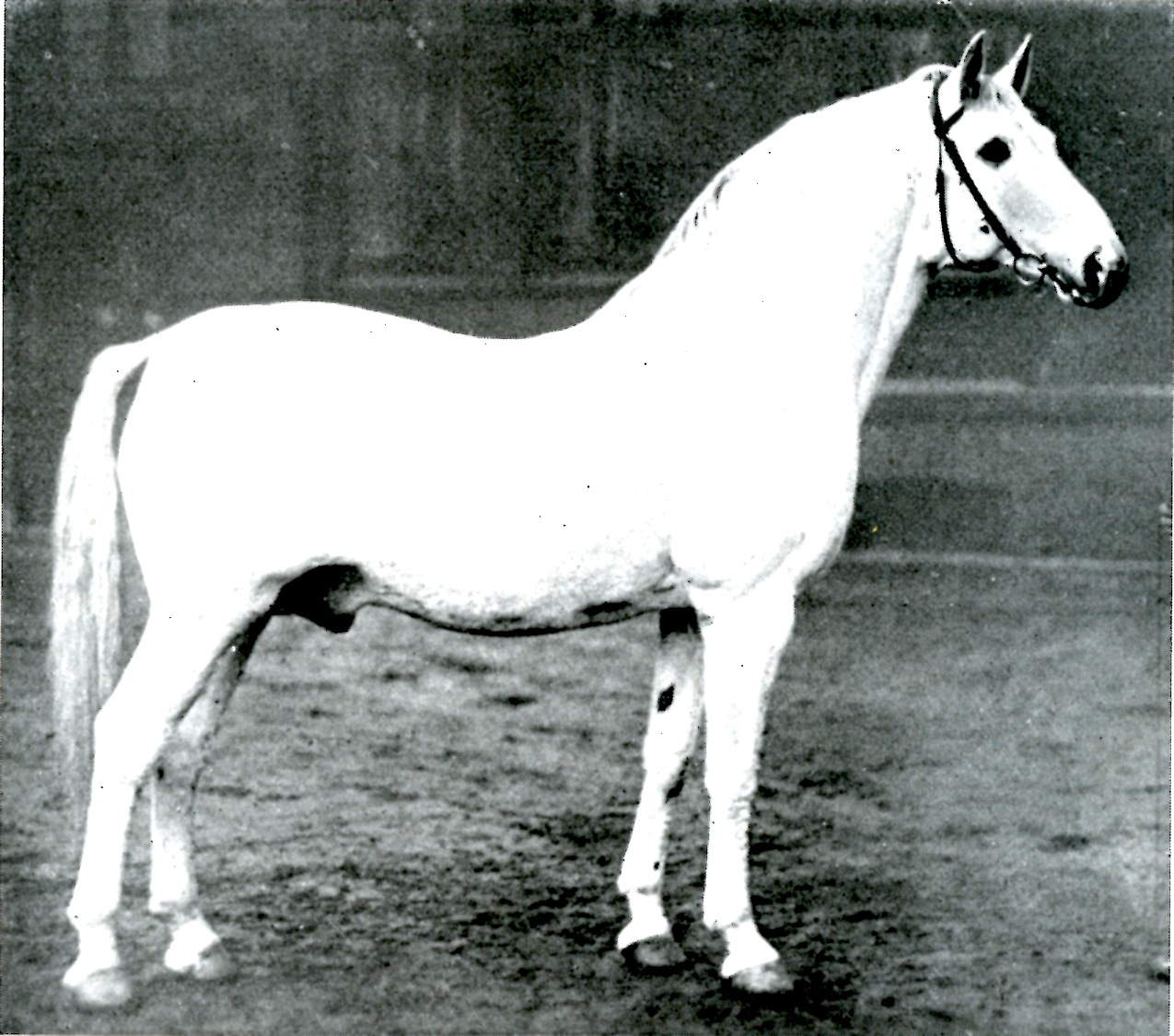
Amateur I – the Arabian influence in Hanover
The A-line through Alderman lost significance after 1950, unfortunately. Today the A-line has changed to an E-line, with two main groups. The major branch traces back to the Celle stallion Eiger I, by Eisenherz/Abermals, born 1975, who was used until 1999. He was a typey but compact stallion, who was very versatile, producing show-jumpers as well as dressage horses. His most successful sport horse, Esprit FRH, was a member of the Gold medal winning German jumping team at the World Championships in Rome 1998 and the Olympics 2000 in Sydney
In 1995 Eiger was Hanoverian Stallion of the Year. Eiger’s best son was the Celle stallion Espri, born 1981. He produced a lot of international jumping horses, but also some excellent Grand Prix horses for dressage. In 1995 he was elected Hanoverian Stallion of the Year. A legendary son of his was the famous E.T. FRH out of a Garibaldi II mother. He won the World Cup Finals two years in a row, in Geneva 1996 and in Gothenburg 1997 with Hugo Simon.
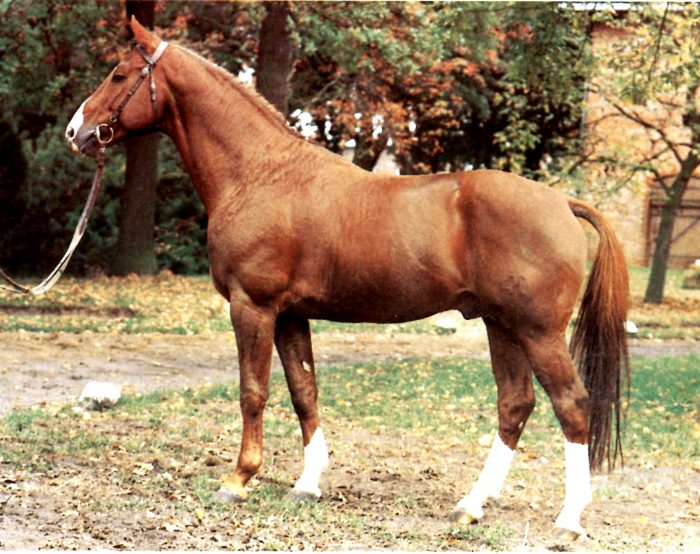
Eiger – jumping and dressage sire
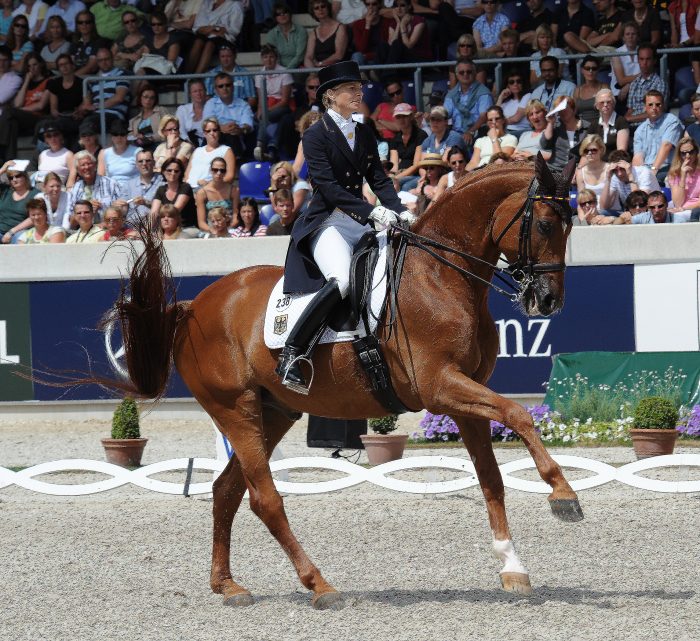
Elvis and Nadine Capellmann, same breeding combination as E.T.
The same sire combination – Espri x Garibaldi II – produced one of the best dressage horses of his time, Elvis, who won the gold medal in dressage with the German team at the Olympics 2008 with Nadine Capellmann.
Espri’s best son was Escudo I, out of a dam by Arkansas, born in 1995. He was a typey jumping stallion, who was very popular. In 2009 he was nominated Hanoverian Stallion of the Year for the quality of his progeny. In North America Escudo-offspring are popular with hunter trainers.
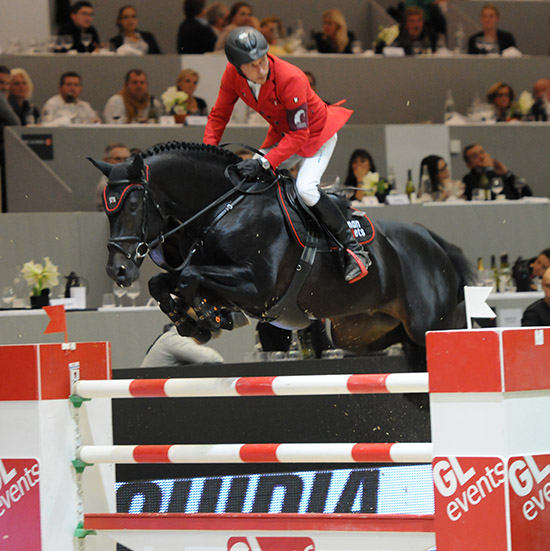
Embassy II, Escudo’s most successful son
Escudo I’s most successful offspring was the international show jumper Embassy II, dam by Silvio. He was the most successful jumping horse as regards prize money per year in Germany in 2012. So far, the prize money won for his rider Hans-Dieter Dreher is more than a million Euro. His full brother Embassy I developed into a successful sire before he died in 2016. He sired successful jumping horses, but also some internationally top eventing horses like SAP Escada FRH, who won team gold with the German team at the World Championships in Caen 2014 and at the European Championships in Malmö 2013 under Ingrid Klimke. The combination also won individual silver at Malmö.
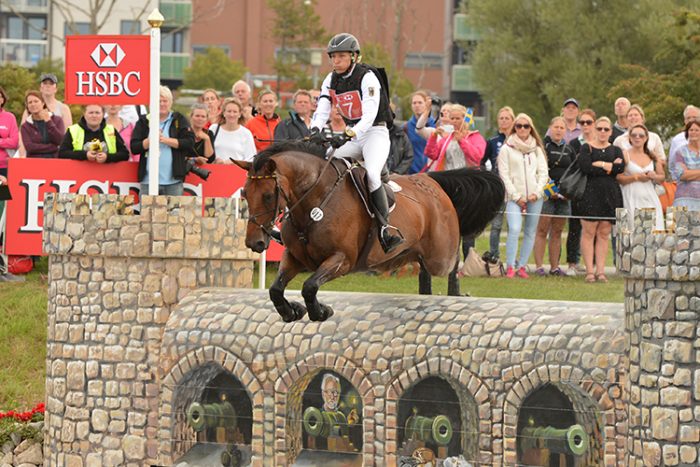
Escada, an eventing medal winner for Escudo with Ingrid Klimke
Another similarly successful eventer was the son of Embassy I, Entebbe de Hus (Carbid), ridden by Karim Laghouag from France. He was part of the French team, which won the gold medal at the Olympics in Rio 2016.
A promising younger stallion of this line is the son of Embassy I, Edward, born in 2005, whose dam is by Fabriano/Singular Joter. He represents the versatility of this line. At his performance test 2008, he excelled both in jumping and in dressage, later on became a very successful young rider’s horse, winning team silver at the European Championships for Young Riders in Compiegne 2013. This versatility can be seen in his offspring, too. Tendency, however, is a little bit more towards jumping.
The second successful branch of the A/E-line was developed in Westphalia, where a lot of Hanoverian blood was used to create their Warmblood horse. This branch traces back to the Celle stallion Eindruck II, whose son Ehrenschild sired Ehrensold, a sire at the Westphalian state stud Warendorf. His son Ehrentusch, was bred in the Rhineland where he was the performance test winner 1987. He sired horses with substance, but also with very good talent for dressage and for show jumping. He developed into one of the most popular stallions in Westphalia and produced some dressage horses for the Olympics.
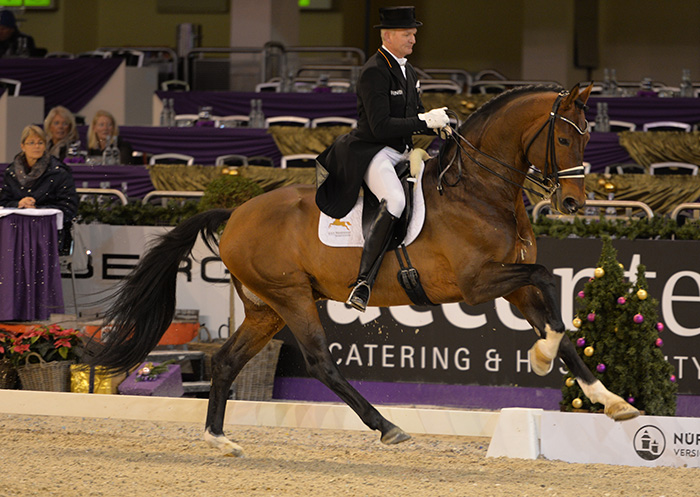
Escolar – the E line lives on….
His grandson Escolar (Estobar/Fürst Piccolo), is currently is one of the most popular stallions in Germany. He became Bundeschampion as a three- and as a four-year-old and currently is one of the most talented younger dressage horses in Germany, ridden by Hubertus Schmidt. He placed second at the Nürnberger Burg-Pokal 2017 at the age of eight and is now competing successfully at Grand Prix.
D-line
The D-line goes back to a Thoroughbred stallion Devil’s Own XX, standing from 1894-1906. His most important son was Detektiv and all D-line stallions today go back to Detektiv. who stood from 1926-1943.
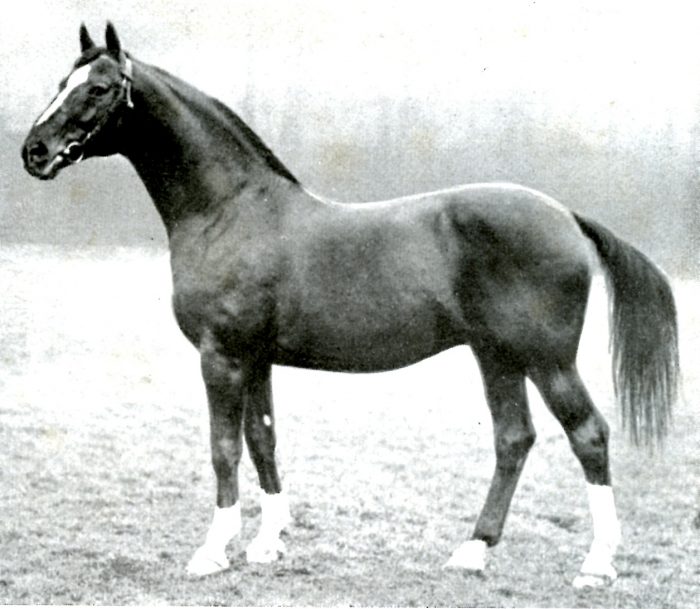
Detektiv – founded the line
The line then split, with the main branch being from the Detektiv son, Dolman.
Dolman, standing from 1937-1953, sired the famous Duellant (1946-1965) who founded a big group of stallions, very good in conformation and movement, and with great dressage talent. His most influential son was Duft II. Duft II’s son Darling (1975-1987) proved to be a good producer of dressage stallions. Darling’s well-known son Dynasty was before his death in 1989, the best dressage horse in Canada. Another very respected sire of dressage horses in Germany was the Duft II son Duerkheim in the State Stud since 1973. He was quite influential in the development of the Hanoverian population in the US with his two sons Diamont, standing at Glenwood Farm in California, and Domingo (Bari von Buedingen, South Carolina).
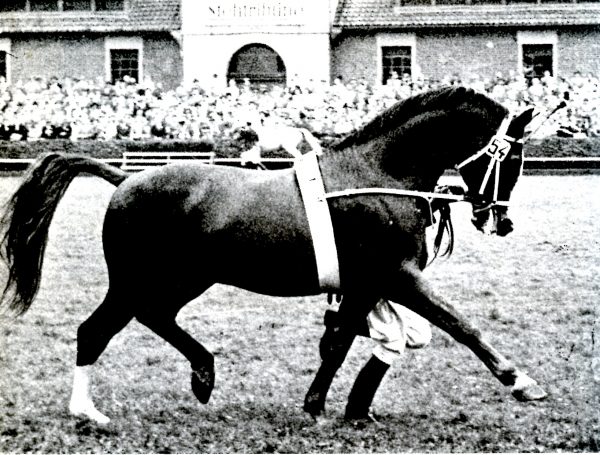
Duellant – his blood lives on today through the bloodlines of German dressage sire,
Breitling W
The stallion Dollart (1941-58) starts a different part of the D-line. more jumping oriented. His great-grandson Diskus sired the world famous US jumper, The Natural. His grandson Dominik sired Don Carlos one of the best-known producers of jumping horses in Hannover. One of the several successful stallions produced by Don Carlos is Dynamo, whose daughter Dollar Girl in the 1990s counted among the best jumping horses in the world with Nick Skelton.
Another Don Carlos son is Don Juan (Waidmannsheil), born 1975, who produced consistently good jumping horses. Yet another Don Carlos son is Drosselklang II (Frustra II), a good jumper. Don Juan (1997) and Drosselklang II (2001) were both nominated Hanoverian Stallion of the Year. The Don Carlos group is remarkable because you find horses of good ‘modern type’ conformation, from very old Hanoverian bloodlines with hardly any Thoroughbred influence.
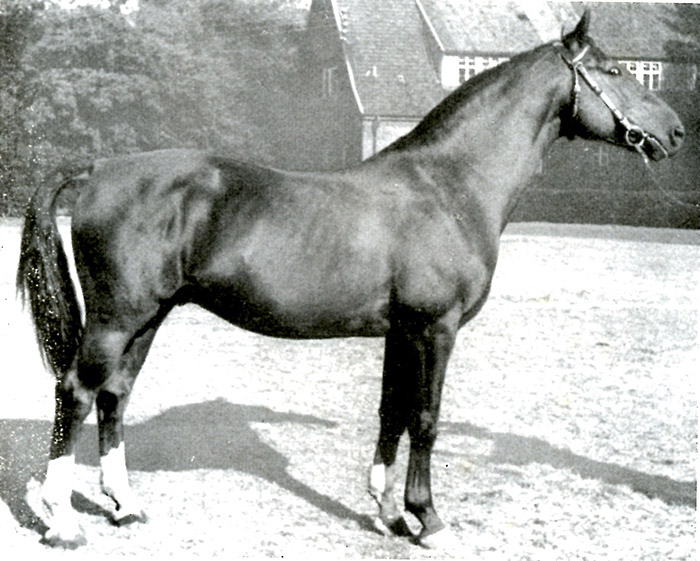
Dwinger – the link to Donnerhall
For the last thirty years, however, the most influential stallion of the D-line has been famous Donnerhall. He traces back to the Detektiv son, Dwinger (Flint), who was born in 1938. Dwinger’s son Diskant (Altmärker) became sire of one of the most legendary Hanoverian jumping horses, Deister (Adlerschild xx), ridden by Paul Schockemöhle, who was European Champion three times, 1981 in Munich, 1983 in Hickstead and 1985 in Dinard and won 1.5 million German marks.
Donnerhall’s dam was the Oldenburg mare Ninette by Markus, bred after classical Oldenburg bloodlines. His sire Donnerwetter (Disput / Matador) stood at the famous stud Grönwohldhof with the very renowned trainer Herbert Rehbein. Grönwohldhof stood Donnerhall, too, and Karin Rehbein trained him up to the highest level. He stood out for his talent for collected work. He was part of the gold medal winning German team at the World Championships at The Hague in 1995 and in Rome 1998, probably becoming the most successful stallion in dressage competition of this time.
Today the Donnerhall branch of the D-line probably is the most successful dressage line in the world. There are so many successful sport horses and sires from this line that it is impossible to give justice to all of them, but two probably need to be mentioned. One is De Niro (Akzent II), who has been named the Number One stallion in the sire rankings of the World Breeding Federation for Sport Horses in the years 2012, 2013, and 2015 until 2017. It is unbelievable, how many Grand Prix horses De Niro, who stood at Klosterhof Medingen, who was successful at Grand Prix himself, sired. His most successful son in competition, who is also a successful sire, is Gestüt Sprehe’s Desperados FRH (Wolkenstein II), who won team gold and individual bronze at the Olympics in Rio 2016 with Kristina Bröring-Sprehe.
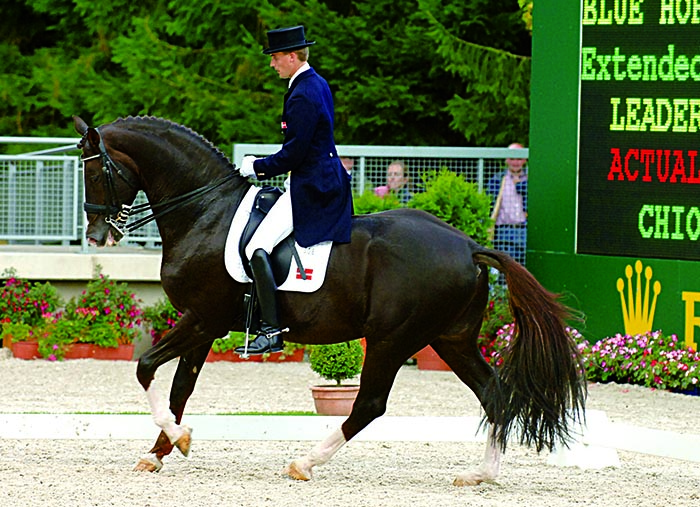
Don Schufro – sire of the world’s number one dressage horse…
The second extremely influential Donnerhall son is Don Schufro out of a dam by Pik Bube. He was purchased by the famous Danish stud Blue Hors and developed into a celebrity in sport and breeding. He himself won the bronze medal at the Olympics in 2008 with the Danish team. He sired a large number of successful Grand Prix horses, crowning his breeding career with No. 1 dressage horse of the world, Weihegold OLD with Isabell Werth.
Amongst his sons in breeding Diamond Hit (Ramino) needs to be mentioned, a successful Grand Prix horse himself and a successful sire of Grand Prix horses.
Once again, thank you Ludwig…
Go to part 2
Have you tried exploring our library?




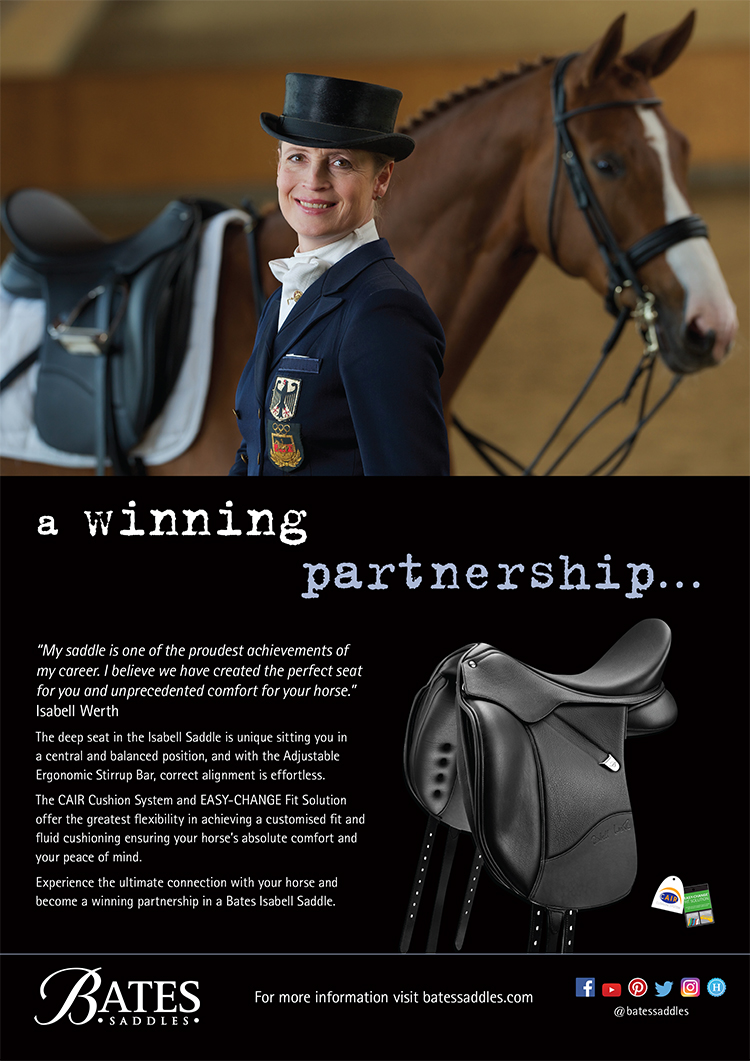
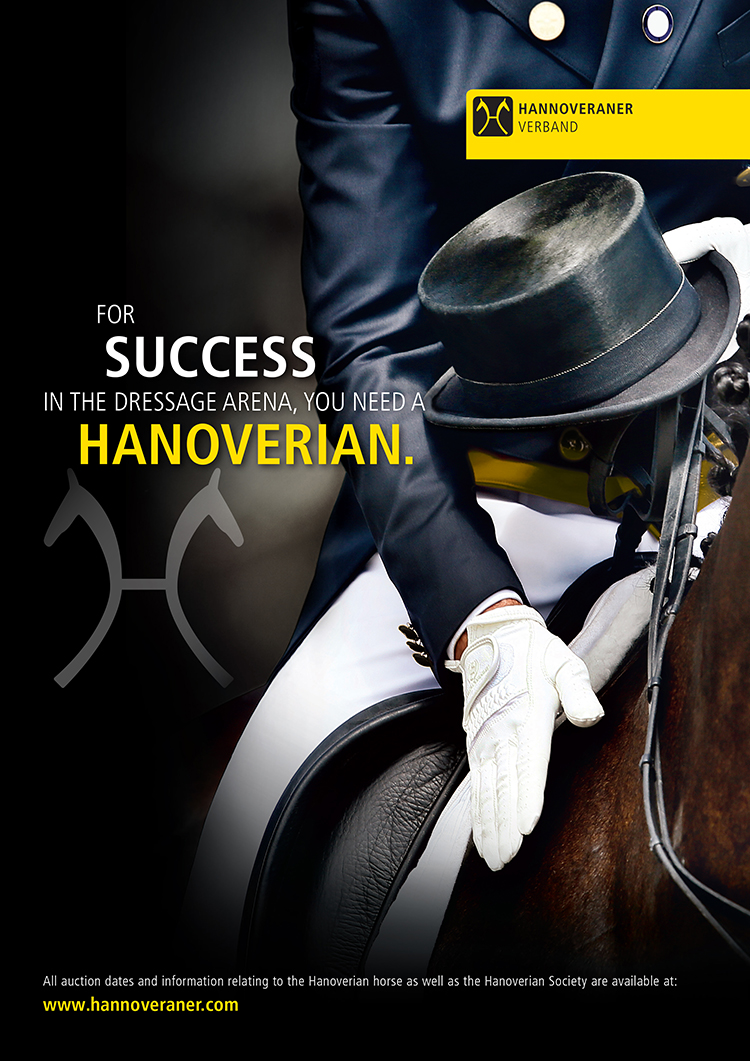
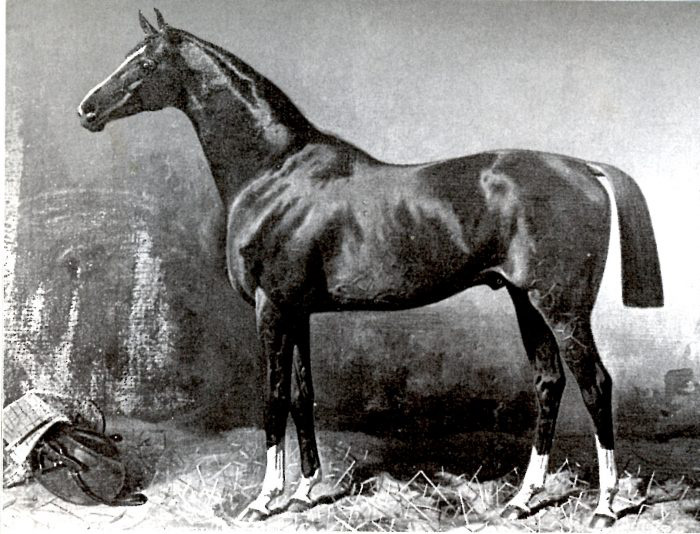
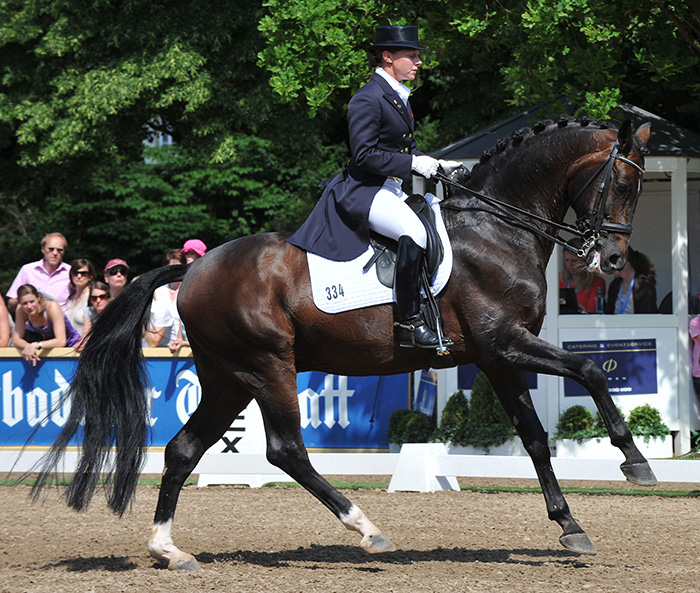
Thanks again for great research and getting me thinking …looking forward to part 11🌞
Love this, fascinating reading, I cant wait to read more, thank you